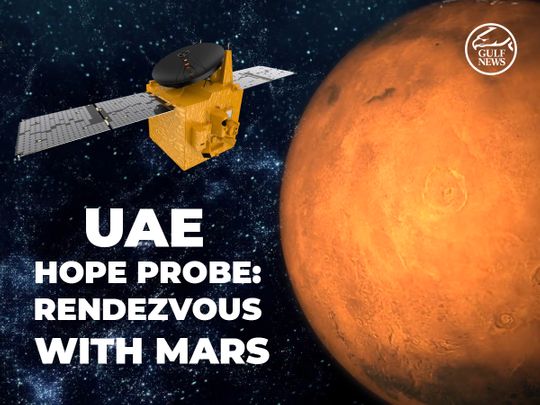
Dubai: Hope Probe, the first Arab interplanetary mission, has successfully transitioned from capture orbit to science orbit, following the completion of a 510-second burn of its thrusters, the Emirates Mars Mission (EEM) announced on Monday.
“Barring the requirement for a minor course correction, the spacecraft is now in its final orbit of Mars and ready for its two-year science data gathering phase — the core aim of the mission — beginning on April 14,” EMM said in a statement.
EMM Project Director Omran Sharaf added: “The Transition to Science Manoeuvre (TSM) was critically important and I can say was the last truly scary moment for the mission because there was a very real risk of losing the spacecraft during this last burn. We’re now assessing the results of that burn, but I can say we are confident that we will not need a further large correction manoeuvre.”
“Although Hope Probe is a huge achievement and a source of great national pride, its core objective, defined right from day one of this mission, is to build the first complete picture of Mars’ atmospheric dynamics,” Sharaf underlined.
‘Big burn’
According to EMM, the TSM saw Hope Probe moved away from its elliptical capture orbit (between 1,063km to 42,461km from Mars’ planetary surface) to a wider scope of 20,000km by 43,000km science orbit. Following the successful transition to the science orbit, Hope Probe will always be higher above the surface of Mars. “The manoeuvre was the last scheduled ‘big burn’ in the spacecraft’s journey since its launch on July 20, 2020. The science phase will commence on April 14 with a number of calibration and test runs that aim to establish a sound baseline for the accurate and efficient management of the measurements from the spacecraft’s three instruments,” the EMM noted.
“The mission’s two-year science data collection will formally commence on May 23, with data being made available globally in October,” EMM added.
Open sharing
Hessa Al Matroushi, EMM Science Lead, explained: “Once we have established our stable science orbit and deployed our instruments, we can start building data sets and testing our systems with the live data. This is the data we will be processing, formatting and sharing with the world’s science and academic communities openly through our website.”
The process of science data gathering consists of making repeated ‘passes’ around Mars and mapping each set of measurements to build a dynamic picture of the movement of dust, ice and water vapour throughout the planet’s atmospheric layers. As well as measuring hydrogen, oxygen, carbon monoxide and Ozone, the probe will capture variations in temperature. The unique elliptical 25-degree orbit of the Hope probe enables a planet-wide, high resolution sample to be taken each 225 hours (9.5 days).
‘Like a spinning wool’
Al Matroushi described how Hope Probe will orbit the Red Planet. She said: “If you imagine spinning a basketball on your finger and then wrapping it with wool as it spins, you get an idea of how Hope Probe covers the whole planet over consecutive orbits. While we’re doing that, we’re constantly measuring with two spectrometers and an imager. These three data streams combine to give us a holistic, powerful and unique picture of Mars’ atmosphere that we hope will answer many, many questions we have about the planet and our theories regarding its atmospheric loss.”
Science instruments
Hope Probe will provide a complete picture of the Martian atmosphere using three highly-advanced science instruments: Emirates exploration Imager (EXI), a 12 megapixel digital camera that captures high-resolution images of Mars along with measuring water ice and ozone in the lower atmosphere through the UV bands: Emirates Mars Infrared Spectrometer (EMIRS) that will collect information on surface and atmospheric temperatures and measures the global distribution of dust, ice cloud, and water vapour in the Martian lower atmosphere; and Emirates Mars Ultraviolet Spectrometer (EMUS) that will measure oxygen and carbon monoxide in the thermosphere and the variability of hydrogen and oxygen in the exosphere.
Emirates Exploration Imager
On March 15, at around 11.am (UAE time) the Emirates exploration Imager (EXI) captured a monochromatic image of the Cerberus Fossae with a spatial scale of approximately 180 meters/pixel. The image was taken near periapsis (nearest point of Hope Probe to Mars) on one of the final transition orbits between Hope’s capture orbit and science orbit.
Cerberus Fossae is a fracture system that stretches for more than 1,000km across the Martian surface. The origin of the fractures themselves may be related to nearby features such as the Elysium and Tharsis volcanic systems. However, the formation and history of these large scars remain somewhat enigmatic. Some have proposed they may have been the source for catastrophic releases of groundwater, perhaps triggered by volcanic activity.
More recently NASA’s Insight lander has identified Mars quakes originating in the Cerberus Fossae fracture system that indicates a tectonically and, perhaps recently, volcanically active system. Evidence for modern-day processes is abundant as erosional wind streaks can be seen behind the large craters in the centre of the image.






